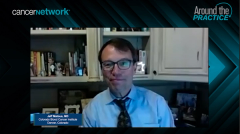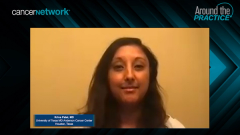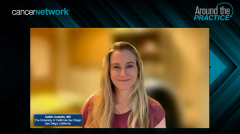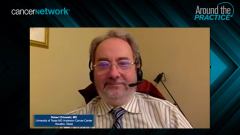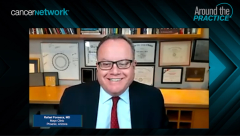
Triplet and Quadruplet Induction Regimens for Transplant-Eligible NDMM: Focus on GRIFFIN and MASTER Trials
An overview of the triplet and quadruplet induction treatment regimens available for patients with transplant-eligible multiple myeloma and key clinical trials studying daratumumab and isatuximab presented at ASH 2021, with emphasis on the GRIFFIN, MASTER and GMMG-HD7 studies.
Episodes in this series

Rafael Fonseca, MD: Welcome to this CancerNetwork® Around the Practice program entitled, “Recent Advances in the Treatment of Multiple Myeloma: Highlights from the ASH 2021 Meeting.” I am your host, Rafael Fonseca. I’m a professor of medicine at the Mayo Clinic in Arizona, and I’m also the chief innovation officer there. I have a great panel of experts who will join the conversation today, so I’m going to go ahead and ask them to self-introduce. I’m sure you will enjoy their comments and their perspectives. Dr Costello, first.
Caitlin Costello, MD: Hi. Thanks, Dr Fonseca. My name is Caitlin Costello. I am an associate clinical professor of medicine at the University of California San Diego, and I am delighted to be here with you all tonight.
Rafael Fonseca, MD: Thank you very much. Dr Patel?
Krina Patel, MD: Hi, thank you guys for having me. I’m excited to be here with this great panel. I’m Karina Patel, an associate professor at the University of Texas MD Anderson Cancer Center. And again, excited to be here.
Rafael Fonseca, MD: Welcome, Dr Patel. Dr Matous?
Jeff Matous, MD: Jeff Matous. I’m at Colorado Blood Cancer Institute in Denver, Colorado, and I am a member of the Sarah Cannon Research Institute as well. I’m very happy to be here and have you moderating us, Dr Fonseca.
Rafael Fonseca, MD: Thank you very much, Jeff. Last but not least, Dr Orlowski.
Robert Orlowski, MD: Hi, I’m Bob Orlowski. I’m the director of the myeloma section here at MD Anderson, which is a seat that I’m keeping warm for Dr Patel when she’ll be ready to take over.
Rafael Fonseca, MD: Thank you very much, Dr Orlowski. Well, again, thank you for joining us. Today we’re going to be discussing several key updates from ASH 2021 [American Society of Hematology annual meeting]. We’re going to cover treatments for newly diagnosed transplant-eligible, transplant-ineligible, and relapsing multiple myeloma. We’ll try to put this in the context of the larger landscape of what’s going on in multiple myeloma, with a particular emphasis on how you can apply this in your clinical practice. So, let’s go ahead and begin.
Our first section is going to be the evolving treatment landscape for transplant-eligible patients, and there’s a large number of studies that continue to come forward describing what we think will be the best practices for the approach of those patients. We have questions about the use of monoclonal antibodies, triplets versus quadruplet combinations; for how long, how deep, how does this integrate with our new tools for measurement of response for this patient population? Let me start by asking Dr Costello, we saw at the ASH meeting an update on the 2-year follow-up regarding the GRIFFIN study. Jacob Laubach [MD, MPP,] presented this. What is your take on that, and what are the clinical implications of this study?
Caitlin Costello, MD: I’ve said before that I feel like daratumumab is the gift that keeps on giving, because it keeps showing the importance of including this drug in every step of our treatment regimens here. The GRIFFIN study that was updated at ASH included 24 months of maintenance for these patients and showed what we all kind of were expecting to see, that the addition of daratumumab to the triplet of RVd [lenalidomide, bortezomib, and dexamethasone], both done in induction followed by consolidation, followed by randomized daratumumab-Revlimid [lenalidomide] versus [lenalidomide] maintenance, showed a continued deepening of response after consolidation through maintenance. So, we’re seeing patients who got the quadruplet followed by daratumumab-lenalidomide maintenance are achieving CR [complete response] rates that seem unprecedented. I mean, 80%-plus CR rates with MRD [minimal residual disease] rates that are significant, seeing that from the consolidation through those 24 months of maintenance. There was almost a tripling of MRD negativity at 10-6. We’re seeing that there are such deep responses with daratumumab, in induction, consolidation, maintenance.
Now, it’s important to say that this study wasn’t powered for progression-free survival [PFS], but very clearly you can start to see the trend of those patients who received daratumumab. I think both arms were somewhere in the 80%-plus rate in terms of progression-free survival, and neither of them had reached a median after I think it was just a little over 3 years. No new safety concerns. I think this is proving to us that a quadruplet regimen at induction with maintenance with daratumumab is probably going to be here to stay. I’ve started to incorporate this pretty routinely across the board for my newly diagnosed patients.
Rafael Fonseca, MD: Thank you, and at the end of our conversation I’ll ask that question again because I think the writing is on the wall regarding the quads versus triplets. But speaking of quads, Dr Patel, we saw another one. We saw an update on the MASTER clinical trial, and I know we’ve seen similar results with MANHATTAN. But what did we learn from MASTER that was presented at the ASH meeting?
Krina Patel, MD: Yes, what I really like about this trial is the end point is different. The MRD, we were taking this prognostic tool we have in myeloma to say, can we use it as a predictive tool possibly, and can we stop therapy? We’re using [daratumumab, carfilzomib, lenalidomide, dexamethasone], so instead of bortezomib it’s carfilzomib, unlike the GRIFFIN trial. Then they’re using 4 cycles of induction, transplant, and then consolidation based on your MRD status. They used 0, 4, 8 cycles of consolidation, but if you were MRD-negative 10-5 at least twice, you actually got to stop all therapy and go on observation, which I think is a big feat for patients. But we always say, do we really stop in a disease that’s not curable? Are we going to actually help those patients? I think it was a great study. We saw amazing MRD negativity. It was 80% of patients overall who reached MRD negativity, which is the deepest response we’ve seen in upfront trials, more so than GRIFFIN, when it comes to MRD. And then 66% were MRD at 10-6, which is of course the best, and CR was 86%.
Again, PFS was still 87% at 2 years, so these patients have done really, really well. I think the flip side, though, what they showed is that the MRD resurgence, they’re watching MRD at 6 months after they stopped treatment and then every year, and keeping an eye on what happens to those patients who stop. And especially the high-risk patients—the ultra-high-risk patients, those who had 2 high-risk features—27% of them ended up having MRD positivity, or they had relapsed at 12 months. So again, I think it is a great study to show that we can really get deep responses when using our best therapies up front, but should we be stopping therapy in all patients? I think for standard-risk patients, this looks great. For high-risk patients, I think stopping therapy is something that we have to keep a closer eye on.
Rafael Fonseca, MD: Thank you, I think that’s a great summary. I would say in our clinical practice there are very few things as gratifying as seeing an MRD-negative result, and there are very few things that are as disappointing as seeing emergence of disease after one of those measurements. It’s less common, but it does happen, so we still are learning how to use that.
Transcript edited for clarity.
Newsletter
Stay up to date on recent advances in the multidisciplinary approach to cancer.


